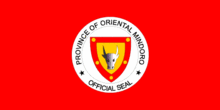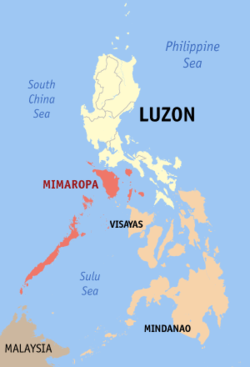Oriental Mindoro
| Oriental Mindoro | |||
|---|---|---|---|
| Province | |||
| Province of Oriental Mindoro | |||
| |||
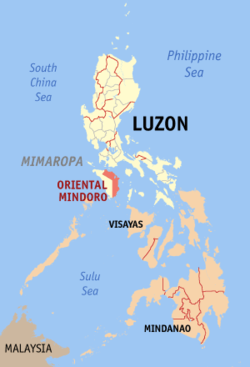 Location in the Philippines | |||
| Coordinates: 13°00′N 121°25′E / 13°N 121.42°ECoordinates: 13°00′N 121°25′E / 13°N 121.42°E | |||
| Country | Philippines | ||
| Region | Mimaropa (Region IV-B) | ||
| Founded | 1955 | ||
| Capital | Calapan | ||
| Government | |||
| • Type | Sangguniang Panlalawigan | ||
| • Governor | Alfonso Umali, Jr. (Liberal) | ||
| • Vice Governor | Humerlito "Bonz" Dolor (Liberal) | ||
| Area[1] | |||
| • Total | 4,238.38 km2 (1,636.45 sq mi) | ||
| Area rank | 28th out of 81 | ||
| Population (2015 census)[2] | |||
| • Total | 844,059 | ||
| • Rank | 32nd out of 81 | ||
| • Density | 200/km2 (520/sq mi) | ||
| • Density rank | 47th out of 81 | ||
| Divisions | |||
| • Independent cities | 0 | ||
| • Component cities |
1
| ||
| • Municipalities | |||
| • Barangays | 426 | ||
| • Districts | 1st and 2nd districts of Oriental Mindoro | ||
| Time zone | PHT (UTC+8) | ||
| ZIP code | 5200–5214 | ||
| IDD : area code | +63 (0)43 | ||
| ISO 3166 code | PH-MDR | ||
| Spoken languages | |||
| Website |
www | ||
Oriental Mindoro (Filipino: Silangang Mindoro, Spanish: Mindoro Oriental) is a province in the Philippines located in the island of Mindoro under Mimaropa region in Luzon, about 140 kilometres (87 mi) southwest of Manila. The province is bordered by the Verde Island Passage and the rest of Batangas to the north, by Marinduque, Maestre de Campo (or known as Sibale but official name is Concepcion) Island, Tablas Strait and the rest of Romblon to the east, by Semirara and the rest of Caluya Islands, Antique to the south, and by Occidental Mindoro to the west. Calapan, the only city in the island, is the provincial capital.
Oriental Mindoro is touted as the country's emerging eco-tourism destination. In 2005, the Philippines was found to be the center of marine fish biodiversity and the home of the most diverse marine ecosystem in the world,[3] by American biologists Kent Carpenter and Victor Springer. Most of the endemic species in the Philippines are found in the Verde Island Passage between Mindoro island and the main island of Luzon. The passage houses 2,983 individual species of algae, corals, crustaceans, mollusks, fishes, marine reptiles, and marine mammals, based on a study conducted by Carpenter and Springer in 2005.
UNESCO declared Puerto Galera a biosphere reserve[4] under its Man and the Biosphere Programme in the 1970s. The Verde Island Passage is at the apex of the so-called Coral Triangle – the Philippines, Indonesia, and Malaysia – which has the distinction of being the "global center of marine biodiversity".
History
Creation
After World War II, reconstruction and rehabilitation of infrastructure and economy took place which ended with the division of the island into two provinces of Oriental Mindoro and Occidental Mindoro on June 13, 1950, by virtue of the Republic Act No. 505.[5]
In the decades after the war, the island continued to become one of the preferred areas of new settlers coming from the overpopulated provinces in the Philippines in search of new land. Apart from the hope to become landowners or to have better tenancy conditions, the guerrilla war (Huk rebellion) in Central Luzon was an important factor for migration. Under the settlement program of the National Resettlement and Rehabilitation Administration (NARRA) which was founded on June 18, 1954, families from Central Luzon were settled in the Bongabong-Pinamalayan area. This project ended in 1956 after the settlement of 606 families (3,636 people) on 8,600 hectares (21,000 acres) of public land. Since then new settlers continue to migrate to Mindoro until today.
Armed conflict
There is currently a conflict going on between the Military and insurgents. On March 6, 2010, eleven soldiers were killed and seven were hurt in a gun battle with the New People's Army in Mansalay, Oriental Mindoro.[6]
Geography
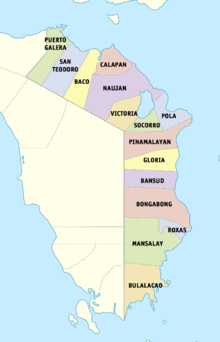
Oriental Mindoro covers a total area of 4,238.38 square kilometres (1,636.45 sq mi)[7] occupying the eastern section of Mindoro island in MIMAROPA region. The province is bordered by the Verde Island Passage to the north, by Marinduque, Maestre de Campo, Tablas Strait and the rest of Romblon to the east, by Semirara and the rest of Caluya Islands, Antique to the south, and by Occidental Mindoro to the west.
The western portion of the province is mountainous or rugged, while the east has hills and flood plains. Mount Halcon, standing 2,582 metres (8,471 ft) above sea level, is the 18th highest mountain in the country and is the province's and island's highest peak. Lake Naujan, the fifth largest lake in the country with an area of approximately 8,125 hectares (20,080 acres) of open water, is located at the northeastern part of the island and the province.
Administrative divisions
Oriental Mindoro comprises 14 municipalities, with one city, Calapan serving as the provincial capital.
- † Provincial capital and component city
- Municipality
| ||||||||||||||||||||||||||||||||||||||||||||||||||||||||||||||||||||||||||||||||||||||||||||||||||||||||||||||||||||||||||||||||||||||||||||||||||||||||||||||||||||||||||||||||||||||||||||||||||||||||||||||||||||||||||||||||||||||||||||||||
Climate
Oriental Mindoro has no distinct wet or dry season. Average temperature ranges from 26 to 32 °C (79 to 90 °F). The province experiences maximum rainfall during the months of June to October. Relative humidity is registered at 81%.
Demographics
| Population census of Oriental Mindoro | ||
|---|---|---|
| Year | Pop. | ±% p.a. |
| 1903 | 26,359 | — |
| 1918 | 43,738 | +3.43% |
| 1939 | 92,530 | +3.63% |
| 1948 | 124,556 | +3.36% |
| 1960 | 228,998 | +5.20% |
| 1970 | 328,364 | +3.67% |
| 1975 | 388,744 | +3.44% |
| 1980 | 446,938 | +2.83% |
| 1990 | 550,049 | +2.10% |
| 1995 | 608,616 | +1.91% |
| 2000 | 681,818 | +2.46% |
| 2007 | 735,769 | +1.06% |
| 2010 | 785,410 | +2.40% |
| 2015 | 844,059 | +1.38% |
| Source: Philippine Statistics Authority[2][8][9][10] | ||
The population of Oriental Mindoro in the 2015 census was 844,059 people,[2] with a density of 200 inhabitants per square kilometre or 520 inhabitants per square mile.
The province is largely rural, with 70% of the population engaged in agriculture and fishing and with only 30% living in urban centers. Tagalog is widely spoken in the province. Other languages spoken are Ilocano and Cebuano. Dialects of the Mangyan language are Arayan, Alagnan, Buhid, Hanunoo, and Tadyawan.[11]
Religion
A very large portion of the population are of Roman Catholic conviction (88%). Other Christian and Islamic belief constitute most of the remaining religious affiliation in the province.
Indigenous people
The indigenous people of Oriental Mindoro are the Mangyans (Manguianes in Spanish, Mañguianes in Old Tagalog), consisting of seven distinct tribes. They occupy the interior, specially the highlands. Mangyans have inhabited the island since pre-history. They are believed to have originally traveled from Indonesia and settled down for good in the island.
Economy
Oriental Mindoro's rich and arable land is suitable for agriculture. It produces large quantities of rice, corn, coconut, vegetables and fruits like calamansi, banana, rambutan, marang or uloy, lanzones and durian. For that, Oriental Mindoro is also known as the Rice Granary and Fruit Basket of Southern Tagalog. It still is the Banana King and Calamansi King of the region. Its total agricultural area is 169,603.34 hectares (419,099.0 acres). Based on agricultural statistics, 85,244 hectares (210,640 acres) are devoted to palay production while 21,671 hectares (53,550 acres)s to coconut plantation. The province, for the past years, registered an average of 1 to 2 million cavans as surplus in rice production.
Tourist attractions
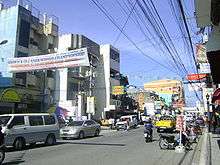
Access from Luzon via the Batangas ports mostly goes through the Verde Island Passage to reach Puerto Galera, the key entry point to Oriental Mindoro. In November 2004, Puerto Galera was voted a member of the UNESCO-affiliated ‘The Club of the Most Beautiful Bays in the World. Puerto Galera features a natural harbor which also protects ships, yachts and bancas from strong typhoons sweeping in from the Pacific.
Puerto Galera, known for white sand beaches and the accompanying honky tonk bar scene on some key beaches, is known for its dive sites with a biodiversity of marine life in and around the coral reefs. Underwater rock formations and coral gardens are home to a variety of marine life, which include numerous species of nudibranch, mantis shrimp, sea anemone, moray and sea fan sea horses. The seas off the coast are host to passing dolphin pods and even the rarer whale shark, and are part of the migratory small whale route from the Visayas.
Towering 8,488 feet (2,587 m) above sea level, Mount Halcon in Baco, the country's third highest peak, is a popular mountain climbing destination. Local and migratory birds allow birdwatching activities. The province is home to endemic wildlife like the tamaraw, a straight-horned water buffalo.
Other tourist destinations include:
The attraction consists of a natural spring with a swimming pool and picnic cottages. It is located in Baco, and can be reached in 45 minutes by taking a jeepney bound for the Calapan market.
The island measures 5 ha and is noted for its white sand. The place serves as the breeding place of seagulls and turtles. Corals and oysters can be found all around the area. The island is also called "Target Island" because Americans used the island for bombing practice in 1946. It is located in Baco, and can be reached in an hour through a motorized banca from the market square.
It is a rocky island, except for the area facing Buyayao Peninsula. Big snakes called "sobre kama" are found in the mountains. The water around the island is suitable for deep-sea fishing. It is located off the coast of Mansalay, and can be reached in 30 minutes by motorized banca from Mansalay market.
This is a public beach with cottages and other facilities. It is a favorite place for the local people, especially during the summer. It is located in Suqui, Calapan, and can be reached in 15 minutes by taking a tricycle from the town proper.
The place is a good spot for picnicking and swimming, especially during the summer. It is located in Pili, Pinamalayan, and can be reached by taking a jeepney to the port of Barangay Wawa, then an hour’s ride by motorized banca to the beach.
It is a secluded beach, with a 2-kilometre (1.2 mi) white sand beach. It is located in Bongol, Pinamalayan, and can be reached in two hours by boarding a Bongol-bound jeepney from the town proper of Pinamalayan and then a tricycle to the beach area.
The 423-foot (129 m) waterfalls, situated alongside the road, is actually a series of asymmetrical falls, leading to the grand one, dropping to a frothy waterbed below. The cascading waterfalls are a great attraction to passers-by. Tamaraw Falls is located in Barangay Villaflor, Puerto Galera. It can be reached in two hours by taking a jeepney bound for Barangay Villaflor from Puerto Galera, or Calapan.
An ideal place for swimming, snorkeling, and scuba diving. There are a number of resorts that offer accommodation and other travel and aqua sports facilities to both domestic and international tourists. It is located in La Laguna, Puerto Galera, and can be reached in 30 minutes from the town proper of Puerto Galera by taking a jeepney bound for La Laguna.
This area is ideal for swimming, snorkeling, and scuba diving. A cluster of nightspots abound in this area, which make it popular for evening socials. Cottages with entertainment facilities stand close to each other. Low-budget accommodations are available. It is located east of Puerto Galera, and can be reached in 15 minutes from the Puerto Galera pier by taking a jeepney or an outrigger banca.
Contrary to its name, Small La Laguna is bigger than La Laguna, and has more facilities. It has coral reefs, and its water is ideal for snorkeling and scuba diving. There are diving equipment for rent at nearby dive shops. It is located beside Sabang Beach, and can be reached in 20 minutes from the pier by taking a jeepney bound for Sabang.
This area is not as busy as the other beaches in Puerto Galera. Thus, it is an ideal site for private swimming. It is located in Puerto Galera, and can be reached in 40 minutes by taking a jeepney or an outrigger boat from the town pier.
The white sandy strips of this beach offer excellent opportunities for swimming. Resorts in this area provide entertainment facilities for tourists' greater amusement and leisure. It is located in Barangay San Isidro, Puerto Galera, and is accessible in 30 minutes from the town proper by a jeepney or a boat.
This beach is far from the busy areas of Puerto Galera; thus, it is ideal for those who seek privacy and retreat. It is located in Puerto Galera, Oriental Mindoro, and can be reached by taking a 10-minute jeepney ride from the town proper, to about one kilometer on the beach mark. The remaining distance is covered on foot.
It is a beige-colored sandy beach with cottages for rent. It is located in Roxas, Oriental Mindoro, and can be reached in 10 minutes by a banca from the pier.
Education
Higher education institutions in the province:[12]
- Abada College
- ACMCL College
- AMA CLC College of Calapan (ACLC College)
- Baco Community College
- Clarendon College
- CLCC Institute of Computer, Arts & Technology
- Dalubhasaan ng Lungsod ng Calapan (City College of Calapan)
- Divine Word College of Calapan
- Eastern Mindoro College
- Eastern Mindoro Institute of Technology and Sciences
- Erhard Science and Technological Institute - Oriental Mindoro Inc.
- Filipino Academy of Scientific Trades
- Grace Mission College
- Innovative College Of Science in Information Technology
- IATEC Computer College
- Institute of Business Science and Medical Arts
- John Paul College
- Luna Goco Colleges
- Mindoro State College of Agriculture and Technology
- Mindoro Bible College
- Paradigm College of Science and Technology
- Polytechnic University of the Philippines - Bansud
- Prince of Peace College
- Southwestern Institute of Business and Technology
- Southwestern Maritime Institute Foundation
- Saint Augustine Seminary
- Simeon Suan Vocational and Technical college
- St. Anthony College Calapan City
References
- ↑ "List of Provinces". PSGC Interactive. Makati City, Philippines: National Statistical Coordination Board. Archived from the original on January 21, 2013. Retrieved 29 October 2012.
- 1 2 3 4 Census of Population (2015): Highlights of the Philippine Population 2015 Census of Population (Report). PSA. Retrieved 20 June 2016.
- ↑ "Carpenter, Kent; Springer, Victor, "The center of the center of marine shore fish biodiversity: the Philippine Islands", Environmental Biology of Fishes, Volume 72, Number 4, April 2005, pp. 467-480(14)".
- ↑ "Puerto Galera Biosphere Reserve".
- ↑ "Republic Act No. 505 - An Act to Create the Provinces of Oriental Mindoro and Occidental Mindoro". Chan Robles Virtual Law Library. 13 June 1950. Retrieved 16 April 2016.
- ↑ http://www.gmanetwork.com/news/story/185470/news/regions/11-soldiers-killed-7-others-hurt-in-npa-ambush-in-oriental-mindoro
- 1 2 3 "Province: Oriental Mindoro". PSGC Interactive. Quezon City, Philippines: Philippine Statistics Authority. Retrieved 8 January 2016.
- 1 2 Census of Population and Housing (2010): Population and Annual Growth Rates for The Philippines and Its Regions, Provinces, and Highly Urbanized Cities (PDF) (Report). NSO. Retrieved 29 June 2016.
- ↑ "Region IV-B (MIMAROPA)". Census of Population and Housing (2010): Total Population by Province, City, Municipality and Barangay (Report). NSO. Retrieved 29 June 2016.
- ↑ "Census 2000; Population and Housing; Region V" (PDF). Philippine Statistics Authority (National Statistics Office - Region V). Retrieved 29 June 2016.
- ↑ http://www.mangyan.org/content/mangyan-groups
- ↑ http://www.ched.gov.ph/chedwww/index.php/eng/Information/List-of-Higher-Education-Institutions-HEIs/REGION-IVB
External links
-
 Media related to Oriental Mindoro at Wikimedia Commons
Media related to Oriental Mindoro at Wikimedia Commons -
 Geographic data related to Oriental Mindoro at OpenStreetMap
Geographic data related to Oriental Mindoro at OpenStreetMap - Local Governance Performance Management System
- Bird Watching Philippines
 |
Batangas Isla Verde Passage |
Sibuyan Sea / Marinduque |  | |
| Occidental Mindoro | |
|||
| ||||
| | ||||
| Sulu Sea | Tablas Strait / Romblon |
